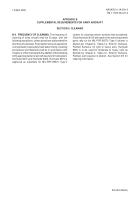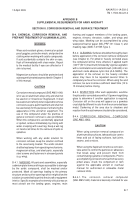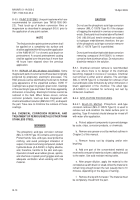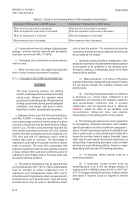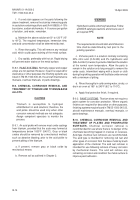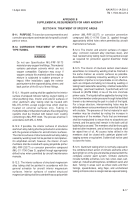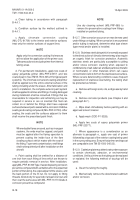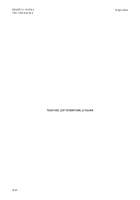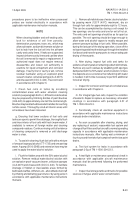TM-1-1500-344-23-2 - Page 216 of 240
B-14
NAVAIR 01-1A-509-2
TM 1-1500-344-23-2
15 April 2009
f. If a red stain appears on the parts following the
above treatment, remove the stain by immersing parts
in a solution containing sulfuric acid (A-A-55828), 4-10%
by volume, sodium dichromate, 4 -8 ounces per gallon
of solution, and water, remainder.
g. Maintain the above solution at 60
°
to 120
°
F (15
°
to 49
°
C). The required temperature, immersion time,
and acid concentration shall be determined by test.
h. Rinse thoroughly. This will remove any residual
acid, which could cause staining of the metal surface.
i. Dry rapidly, preferably with hot air. Rapid drying
will prevent water stains on the metal surface.
B-8.3. PAINT SYSTEMS. Normally copper and copper
alloys are not painted. However, if paint is required for
decorative or other purposes the finishing systems are
listed in TM 55-1500-345-23, the aircraft maintenance
manuals, overhaul manuals, or parts drawings.
B-9. CHEMICAL CORROSION REMOVAL AND
TREATMENT OF TITANIUM AND TITANIUM-BASE
ALLOYS.
CAUTION
Titanium is susceptible to hydrogen
embrittlement in acid solutions; therefore, the
acid pickle should be used only when other
corrosion removal methods are not adequate.
Assign competent operators to monitor the
process.
B-9.1. An acid pickle will remove most oxide coatings
from titanium, provided that the scale was formed at
temperatures below 1000
°
F (540
°
C). Gray or black
oxides should be removed by a mechanical method,
such as abrasive blasting, prior to the acid pickle to
prevent pitting of the titanium.
a. If present, remove gray or black oxide by
mechanical means.
b. Remove soil as outlined in Chapter 2.
WARNING
Hydrofluoric acid is extremely hazardous. Follow
all MSDS safety precautions and ensure use of
all required PPE.
NOTE
The required acid concentration and immersion
time shall be determined by test prior to the
pickling operation.
c. Immerse parts in a solution normally containing
20% nitric acid (O-N-350) and 3% hydrofluoric acid
(MIL-A-24641) in water, by volume. Maintain the solution
at the normal room temperature. Allow the parts to
remain in the solution only long enough to remove the
oxide coats. Intermittent wiping with a brush or cloth
during the pickling operation will facilitate oxide removal
with a minimum of pitting.
d. Rinse thoroughly in cold running water, air dry, or
dry in air oven at 180
°
to 240
°
F (82
°
to 116
°
C).
e. Apply final protective finish, if required.
B-9.2. PAINT SYSTEMS. Titanium does not require a
paint system for corrosion protection. Where organic
finishes are required for decorative or other purposes,
finishing systems may be found in TM 55-1500-345-23,
aircraft maintenance manuals, overhaul manuals, or
parts drawings.
B-10. CHEMICAL CORROSION REMOVAL AND
TREATMENT OF PLATED AND PHOSPHATED
SURFACES.
Chemical corrosion removal is
recommended for use where there is no danger of the
chemicals becoming trapped in crevices or recesses.
Acid-type chemical rust removers are recommended.
The acid type is intended for removing red rust and
other types of corrosion from the base metal by brush
application of the chemical. The acid rust remover is
intended for use following removal of heavy corrosion
by mechanical means. The acid will remove any
remaining corrosion and condition the metal surface to
improve paint adhesion.
Back to Top


